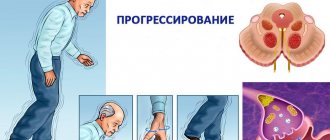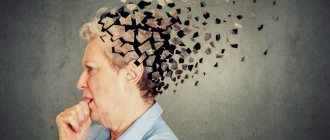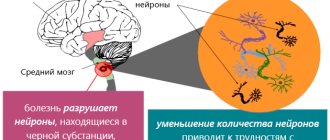Niemann-Pick disease is a hereditary disease that is characterized by an increase in size and dysfunction of the liver and spleen, and in some cases, the development of mental disorders - epilepsy, dementia, developmental delays in children. The cause of these phenomena is the accumulation of fats in tissues with the gradual transformation of cells into a storage of sphingomyelin and cholesterol.
Scientists distinguish 4 types of Niemann-Pick disease, which are designated by the first letters of the Latin alphabet - A, B, C and D. Each of them is caused by various defects in the 11, 14 or 18 pairs of chromosomes. Type A is considered the most dangerous and malignant. It is diagnosed in the first months of life and without effective treatment, babies rarely manage to live more than two years.
Symptoms
The clinical picture of Niemann-Pick disease can be different, which led to its division into types. In more than 70% of cases, the pathology occurs as type B. In this case, the first symptom in infants is jaundice in the first months of life. By 2-3 years, a slight increase in the size of the liver and spleen and digestive disorders are recorded. At 6-8 years old, children often complain of abdominal pain, nausea and vomiting. Disruption of the spleen quickly affects the formation of platelets - in children with Niemann-Pick syndrome, blood clotting is impaired.
In the absence of effective treatment methods, fatty compounds begin to be deposited in the lungs. By adolescence, the patient’s chart shows frequent notes about bronchitis and pneumonia, and there are frequent cases of ascites - a sharp enlargement of the abdomen associated with disruption of the portal vein.
In type C, Niemann-Pick disease is also accompanied by disorders of the nervous system: children are developmentally delayed and often suffer from epileptic seizures and dementia. Symptoms of cirrhosis of the liver and obesity of the spleen progress so quickly that by the age of five a complex operation to remove their lobes may be required. Every year, treatment of Niemann-Pick disease abroad becomes more of a vital necessity, regardless of the cost and the need for flights.
Heredity and genetics
Alzheimer's syndrome is one of the types of senile dementia, and the most common.
Statistics show that more than 50% of elderly people are susceptible to this disease to one degree or another. Is Alzheimer's disease inherited?
Geneticists have been able to establish through research that there is indeed some dependence on hereditary factors: the likelihood of developing senile dementia of the Alzheimer's type increases significantly if one of the close relatives has been affected by this disease.
In the case where dementia affects not one, but two family members, this fact should seriously alert the younger generation: the probability doubles, as evidenced by statistical data.
From the editor: Structure of the vascular system of the head and neck, its pathologies and treatment
These data allow scientists to claim that this disease is hereditary in nature, that is, it is genetically determined.
The disease affects brain cells, the volume of which decreases, which is visible to the naked eye according to the results of CT and MRI studies.
Alzheimer's syndrome is not infectious, which excludes the possibility of infection. It is impossible to become infected with this disease: it is not the disease that is transmitted, but a predisposition to it.
The mechanism of the occurrence of dementia is not fully understood; there are many theories about what exactly serves as an impetus for the body.
The discovery of symptoms similar to the manifestations of this particular disease does not give reason to make such a diagnosis for yourself, even if several ancestors suffered from dementia.
You can find a test on the Internet and answer questions - it’s interesting and educational, but it does not answer the question of whether Alzheimer’s disease has begun to progress.
Only specialists, after conducting a series of tests and studies, will be able to make an accurate diagnosis, because the manifestations of this disease only indicate memory problems, and similar symptoms are observed in other diseases.
For example, atherosclerosis also leads to the development of senile dementia, but it is still a completely different disease that requires different preventive and medicinal measures.
Heredity, age, gender as causes of Alzheimer's disease:
Diagnosis of the disease
As a rule, typical symptoms of the disease can be noticed already in the first months of the baby’s life. Enlarged liver and spleen, indifference to the environment and lethargy are the first signs of pathology, when detected, the child is sent for tests to a genetics center. Nowadays a whole range of techniques is used that allows not only to establish a diagnosis, but also to determine the type of disease and make predictions.
- In skin cell culture, defects in 11, 14 or 18 pairs of genes are detected;
- analyze the activity of sphingomyelinase in a culture of leukocytes;
- The most accurate results are obtained from a bone marrow biopsy, which reveals characteristic “foam” cells.
Treatment of Niemann-Pick disease abroad does not begin without additional diagnostics necessary to determine the extent of anatomical changes in organs and tissues. A computed tomography scan of the brain, an ultrasound scan of the abdominal cavity, and psychiatric tests are required.
When should you see a doctor?
The first visit to the doctor should be at the moment when the couple is planning to have a child, if there are relatives in the family with Niemann-Pick genetic pathology.
It is also necessary to consult a geneticist if the child has signs of sphingomyelinosis pathology:
- The child is developmentally delayed;
- The child has insufficient appetite, or its complete absence;
- The baby is not gaining enough body weight.
Treatment of pathology in Germany
For many years, only a number of medications were used to treat Niemann-Pick disease to alleviate the symptoms of the disease. In chronic cases of types B and C, this approach made it possible to significantly improve the patient’s quality of life and prolong his life.
Today, treatment of Niemann-Pick disease in Germany is based on the latest advances in medicine and genetics. Drugs that block the synthesis of sphingomyelin, the accumulation of which is the cause of enlargement of internal organs and mental disorders, are widely used. Their use is indicated for patients throughout their lives.
High results are achieved by bone marrow transplantation, in which stem cells with a defective genotype are replaced with healthy ones.
The timing of a transplant is determined not so much by the price as by the time it takes to find a suitable donor. Having healthy relatives with a suitable set of immunoglobulins simplifies the task. If the organs are significantly enlarged, surgery is performed to remove the spleen and resection of the liver.
Prices for Niemann-Pick disease treatment in Germany vary depending on the number of procedures and surgeries required. A benign course of type B extremely rarely requires a surgical solution, while type A requires urgent qualified intervention.
Symptoms
Pick's disease has three stages in its course, which develop depending on the lesion, as follows:
- Initial stage.
- Stage of loss of cognitive functions.
- Profound dementia.
initial stage
The symptoms of the disease at the very first stage are not much different from the symptoms of Alzheimer's disease, the difference is that the course of the disease is more rapid and malignant.
Thus, at the initial stage, a person’s boundaries of what is permitted are erased, he becomes more liberated and does not realize what caused dissatisfaction with this or that action on his part, a disinhibition of instincts occurs, all this leads to the following manifestations:
- antisocial behavior;
- selfishness;
- loss of moral principles;
- increased libido;
- decreased self-criticism;
- “gramophone record” symptom (repeated repetition of phrases, jokes, stories, some “secret” information).
In addition, there is a possibility of developing bulimia, and depending on which hemisphere is affected by depression or excessive euphoria (the left hemisphere is depressive, the right is euphoric).
In addition, additionally, in the case of convexital atrophy of the frontal lobe, the patient experiences:
- apathy;
- loss of desires;
- silence.
In the case of frontal lobe atrophy:
- personal changes;
- emotional instability.
With changes in the temporal lobes, the patient becomes overly suspicious, he feels abandoned and useless, which also leads to the formation of depression.
Stage of cognitive loss
At this stage, in addition to the previously listed symptoms, disorders associated with the cognitive functions of the body are added, including:
- loss of writing, counting and reading skills;
- memory impairment;
- inability to perform actions consistently (lack of logic in actions);
- decrease in speech reserve (up to the state of “Ellochka the cannibal”);
- inability to consciously perceive what is said to him.
At the very beginning of the second stage, these symptoms and signs may appear periodically, but every day the periods of normal functioning of the body become shorter and shorter, and cognitive impairment eventually becomes chronic and occurs constantly.
In addition, in some cases there is a phenomenon such as sudden changes in weight. First, the patient sharply gains weight and is diagnosed with obesity, after which the gained weight almost doubles. This entails disruption of physiological processes in the patient’s body, general weakness and exhaustion.
Profound dementia
This stage is fatal and usually leads to the death of the patient. It is characterized by the patient’s inability to perform basic actions (use of cutlery, use of personal hygiene products, etc.).
As a rule, at this stage the patient is completely immobilized and bedridden. Death occurs as a result of the formation of concomitant infectious diseases and symptoms characteristic of bedridden patients.
DMU: comprehensive treatment support in Germany
Severe syndromes and a threat to the life of a child with Niemann-Pick disease dictate their conditions to parents - treatment must be provided regardless of its price, with high quality and without delay. If at the same time you are stopped by a difficult choice and search for a clinic, lack of language knowledge, fear of flying, the need for accommodation in a foreign country and the difficulty of obtaining visas, our specialists are ready to help and take responsibility for all organizational issues. After all, Niemann-Pick disease in Germany is considered and treated comprehensively, which makes it possible to compensate for the pathology at any age.
Specialists from the DMU center in Russia will be by your side throughout the entire treatment cycle:
- we will select the best specialists in Germany for you, provide an estimate, treatment plan and schedule a visit;
- We will help you with obtaining a medical visa;
- we will book tickets and accompany you from departure to return home;
- There will be a professional translator next to you who will explain everything the doctor says.
You can be sure that the prices for each service are justified. Our coordinators carefully check the invoices issued and compare them with the price list recommended by the German Ministry of Health. Treatment abroad can be your ticket to a new life, and we are ready to support you in every action.
Systemic degenerations of the nervous system of hereditary nature
Diseases of the 1st class include pathologists characterized by damage to the cerebellum and the structures that provide its connections. These diseases include spinocerebellar ataxia, including:
- Pierre-Marie ataxia;
- familial Friedreich's ataxia;
- late cortical cerebellar atrophy of Marie-Foy-Alajouanin;
- olivocerebellar atrophy;
- olivo-ponto-cerebellar degeneration of all types.
The second subclass of degenerative diseases of the nervous system includes pathologies characterized by damage to the pyramidal tracts. Such diseases include:
- spastic familial paraplegia of Strumpel;
- Ferguson-Critchley multiple sclerosis;
- spastic paraplegia accompanied by retinal degeneration.
- Parkinson's syndrome;
- hepatocerebral dystrophy;
- chronic Huntington's chorea;
- calcification of the basal ganglia;
- trembling;
- Gilles de la Tourette syndrome;
- hereditary progressive myoclonus epilepsy;
- double athetosis;
- hereditary deforming dystonia.
The last subclass is represented by neuroretinal degenerations. A striking example of diseases belonging to this subclass is Leber's hereditary optic atrophy, as well as Lawrence-Moon-Biedl syndrome.
Life forecast
Unfortunately, the prognosis for the course of the disease is sad. On average, patients with this diagnosis do not live more than 10 years, and the average life expectancy is 5–6 years. This is due to the fact that the patient gradually completely stops functioning normally as a rational being, he is bedridden, and the result is a vegetative coma.
Caring for such patients is a serious test of strength; it is for this reason that a psychiatric hospital is the best option not only for the patient, but also for his relatives. At the very least, they will be confident that the patient is being monitored and given all possible assistance.
So, Pick's disease is a serious genetic disease, the symptoms of which resemble Alzheimer's disease, however, it has a more transient course. You should not neglect visiting specialists if you find similar symptoms in your relatives, as in the long term this will help prolong the life of the sick person and minimize the consequences for the people around him.









